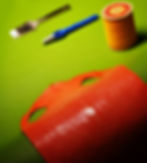What is stingray skin?
Stingray skin, also known as shagreen, is the upper portion of certain species of shark and ray used in leathercraft.
Today, the skins we buy to make wallets, watch straps, wrapped boxes and small bags, are mostly from farmed stingrays in Asia. In particular, Thailand.

The skin has a fibrous flesh side made up of collagen fibres, much like regular leather, but that’s where the similarities end.
The surface is made up of small spheres, sometimes called pearls. They are larger in the centre of the skin and smaller on the outer edges.


Each tiny sphere is made up of a hard substance called dentin, with an even harder outer coating of enamel. Very similar to your teeth.
The stingray uses this tooth like outer armour as a defence system against attack, which is why the spheres only cover the area of the ray around the vital organs.
During processing, the soft meaty exterior wings are removed (for food consumption), and the upper layer of shagreen is sent off for tanning.
This is why stingray skin isn't consistent with the shape of a live stingray.
Most stingray skins are chrome tanned which allows the skin to remain strong and flexible for product manufacture.
There are two types of finishing for shagreen.
One is simply left un-sanded before being dyed a particular colour. This gives a caviar like look to the finished skin (as the above images show). The other finish is sanded.
Sanding is usually done after the dying process where a machine sands away a portion of the surface exposing the un-dyed dentin underneath the enamel. Some finishes are dyed after sanding if a more uniform colour is required.
This will provide a uniform thickness across the skin which is also desirable for book binding, small cases, boxes, cabinets, humidors and wherever a raised effect is undesirable.
Finally, the sanded skin is put through a machine which imparts a polished finish that catches the light, providing a striking appearance (see below picture).

As leathercrafters the issues we face when using this skin are many.
Cutting the skin is the first hurdle.
The material that prevents a predator's sharp teeth from penetrating this armour layer, is also resistant to the knife, pricking iron and awl.
Edge finishing can also be a challenge.
Especially with un-sanded skins, as the variation in the surface allows edge paint to seep between the spheres through capillary action, and the finished result is less than desirable with bleeding colour.
Stitching is another hurdle.
Since no awl can safely penetrate the dentin/enamel layer. Doing so risks stabbing yourself, or worse, blunting your awl blade 😉.
Another problem that plagues us is the texture itself.
No thread is tough enough to tell this unusual surface what to do. The spheres can play havoc with stitching consistency and the look of the completed product.
So how do you tame this wild and unforgiving skin?
Rather than fight the natural tendencies and properties of this precious skin,
it is best to understand it’s strengths and weaknesses and
work with the skin rather than against it.
Now, as you're still here, you obviously take your leathercraft very seriously and you want to learn more.
I would like to give you a FREE course created just for you! This is going to help you improve your knowledge and accelerate your skills faster and higher than you previously thought possible.
Start discovering in minutes, what some masters have taken decades to understand!
Get the information showing you how to use the best leather and skins in your work.
Start by claiming your FREE course which will reveal secrets known only to select tanneries and master leather craftsmen, and very shortly - YOU!.
P.S. For a limited time there will also be a BONUS 20 page tool buyers guide which will help you to understand which tools you need and which tools you don't, depending on your experience (The '3 step method ').
